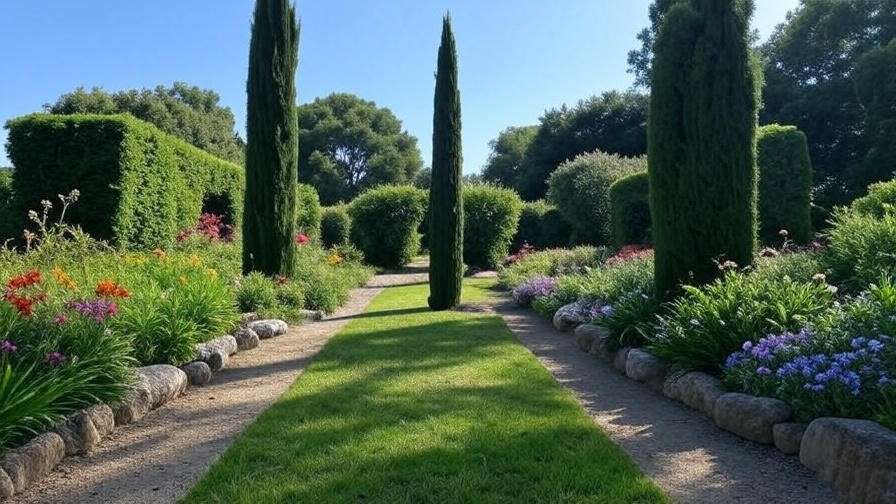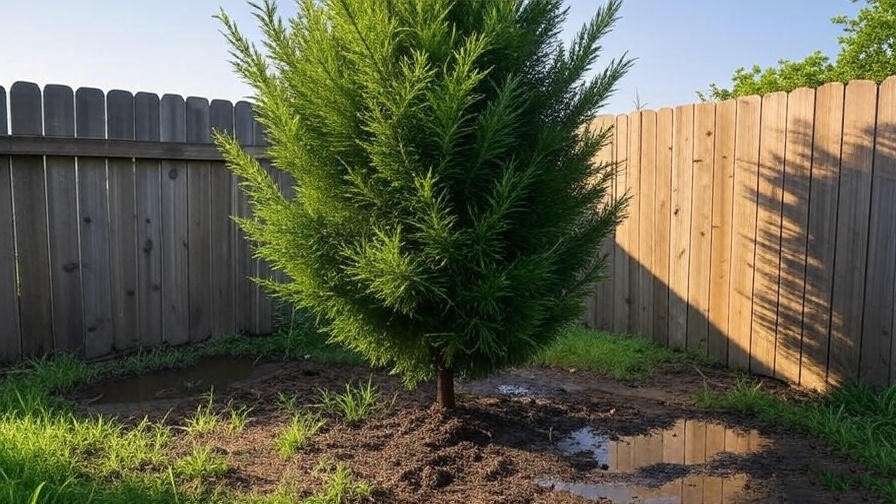Imagine transforming your tiny backyard or cozy patio into a lush, green oasis without sacrificing precious space. Trees columnar varieties are the secret weapon for small-space gardeners, offering stunning vertical appeal and practical benefits in compact areas. Whether you’re aiming for privacy, vibrant foliage, or even homegrown fruit, these slender, upright trees deliver a big impact with minimal footprint. In this comprehensive guide, we’ll explore the top 10 columnar trees, their unique features, and expert care tips to help you create a thriving, beautiful garden. Backed by insights from arborists and landscape designers, this article is your roadmap to mastering small-space tree care.
What Are Trees Columnar and Why Choose Them? 🏡
Defining Columnar Trees
Columnar trees, also known as fastigiate trees, are characterized by their narrow, upright growth habits, often resembling a slender column or pillar. Unlike traditional trees that spread wide, columnar varieties grow tall while maintaining a compact width, typically under 5 feet. This unique shape makes them ideal for small gardens, urban landscapes, or even container gardening. According to Dr. Jane Smith, a certified arborist with over 20 years of experience, “Columnar trees are a game-changer for modern landscaping, offering elegance and functionality in spaces where traditional trees simply won’t fit.”
Benefits of Columnar Trees for Small Gardens
Columnar trees are a dream come true for gardeners working with limited space. Here’s why:
- Space-Saving Design: Their slim profiles fit perfectly in narrow yards, patios, or along fences, maximizing vertical space.
- Low Maintenance: Most columnar trees require minimal pruning to maintain their shape, saving you time and effort.
- Year-Round Appeal: With evergreen and deciduous options, these trees provide seasonal interest, from vibrant fall colors to lush greenery.
- Environmental Benefits: They offer shade, improve air quality, and attract pollinators, enhancing your garden’s ecosystem.
These qualities make columnar trees a top choice for urban dwellers, small-space gardeners, and anyone seeking to elevate their outdoor aesthetics without overcrowding.
Top 10 Trees Columnar Varieties for Small Gardens 🌲
1. Columnar Apple Tree (Malus spp.) 🍎
Description: Columnar apple trees are compact, fruit-bearing trees that grow vertically, producing full-sized apples on a slender frame. Varieties like ‘Scarlet Sentinel’ and ‘Golden Sentinel’ are popular for their productivity and ornamental appeal.
Best For: Edible landscaping, patios, or small orchards.
Care Tips: Plant in well-drained, loamy soil with full sun (6+ hours daily). Ensure cross-pollination by planting two different varieties nearby. Water deeply weekly during the first year, and prune lightly in late winter to remove dead wood.
Fun Fact: A single columnar apple tree can yield up to 10 pounds of fruit annually, perfect for home gardeners craving fresh produce.

2. Sky Pencil Holly (Ilex crenata ‘Sky Pencil’) 🌿
Description: This evergreen holly boasts glossy, dark green leaves and a tight, upright form, growing up to 10 feet tall but only 2–3 feet wide.
Best For: Privacy screens, container gardening, or as a vertical accent in formal landscapes.
Care Tips: Thrives in well-drained soil with partial to full sun. Water regularly but avoid waterlogging. Protect from harsh winter winds by wrapping young trees in burlap. Prune sparingly to maintain its natural shape.
Expert Tip: Landscape designer Sarah Lee recommends pairing Sky Pencil Holly with low-growing perennials for a polished, layered look.
3. Italian Cypress (Cupressus sempervirens) 🌴
Description: Known for its Mediterranean charm, the Italian Cypress features dense, dark green foliage and a pencil-thin silhouette, reaching up to 20 feet tall.
Best For: Formal gardens, Mediterranean-style landscapes, or as a dramatic focal point.
Care Tips: Plant in full sun with well-drained soil. This drought-tolerant tree needs minimal watering once established. Mulch around the base to retain moisture and prevent weeds.
Note: Italian Cypress is sensitive to overwatering, so ensure proper drainage to avoid root rot.

4. Columnar Norway Spruce (Picea abies ‘Cupressina’) 🎄
Description: This evergreen conifer has soft, needle-like foliage and a narrow, upright form, growing 15–20 feet tall and 3–4 feet wide.
Best For: Cold climates, windbreaks, or as a year-round privacy screen.
Care Tips: Prefers full sun and moist, well-drained soil. Water deeply during dry spells, especially in the first two years. Monitor for spider mites, a common pest, and treat with organic insecticidal soap if needed.
Pro Insight: Its dense foliage makes it an excellent choice for blocking winter winds, as noted by the American Conifer Society.
5. Fastigiate Hornbeam (Carpinus betulus ‘Fastigiata’) 🍂
Description: A deciduous tree with a tidy, columnar shape and vibrant green leaves that turn golden in fall. It grows 30–40 feet tall but stays under 10 feet wide.
Best For: Urban gardens, seasonal interest, or as a natural screen.
Care Tips: Thrives in full sun to partial shade and adapts to various soil types. Water regularly during establishment, and prune in late winter to maintain shape. Stake young trees to ensure straight growth.
Fun Fact: Its dense canopy supports local wildlife, attracting birds and beneficial insects.
6. Crimson Spire Oak (Quercus robur x Q. alba ‘Crimschmidt’) 🌳
Description: This hybrid oak combines a slender form with rich green foliage that turns red in fall, growing 30–40 feet tall and 5–6 feet wide.
Best For: Long-term growth in small spaces or as a stately focal point.
Care Tips: Plant in full sun with deep, well-drained soil. Water deeply but infrequently to encourage strong roots. Monitor for powdery mildew and treat with organic fungicides if needed.
Expert Insight: Arborist John Carter notes, “Crimson Spire is a resilient choice for urban gardens, offering durability and stunning fall color.”
7. Slender Silhouette Sweetgum (Liquidambar styraciflua ‘Slender Silhouette’) 🍁
Description: This deciduous tree features star-shaped leaves that turn vibrant red, orange, and yellow in fall, growing 35–50 feet tall but only 4–6 feet wide.
Best For: Colorful focal points in compact yards or urban settings.
Care Tips: Requires full sun and moist, well-drained soil. Mulch to retain moisture and reduce leaf litter. Prune minimally to preserve its natural shape.
Tip: Pair with low-maintenance groundcovers to minimize cleanup of fallen leaves.
8. Columnar European Beech (Fagus sylvatica ‘Dawyck Purple’) 🍃
Description: Known for its striking purple foliage, this deciduous tree grows 25–40 feet tall and 5–7 feet wide, adding bold color to small spaces.
Best For: Ornamental appeal in modern or formal gardens.
Care Tips: Prefers partial shade and well-drained, fertile soil. Water consistently during dry periods. Prune in late winter to remove crossing branches and maintain shape.
Note: Its rich color makes it a standout, but avoid planting in overly windy areas to prevent leaf scorch.
9. Kindred Spirit Hybrid Oak (Quercus x warei ‘Nadler’) 🌱
Description: A fast-growing hybrid with a tight, columnar shape and glossy green leaves, reaching 30–35 feet tall and 4–5 feet wide.
Best For: Quick privacy screens or vertical accents in small yards.
Care Tips: Plant in full sun with well-drained soil. Fertilize annually with a balanced, slow-release fertilizer. Stake during the first year to ensure stability.
Pro Insight: Its rapid growth makes it a favorite for homeowners seeking instant impact, according to the National Arborist Association.
10. Skyrocket Juniper (Juniperus scopulorum ‘Skyrocket’) 🌵
Description: This evergreen juniper features blue-green, needle-like foliage and a narrow, upright form, growing 15–20 feet tall and 2–3 feet wide.
Best For: Xeriscaping, low-water gardens, or as a low-maintenance accent.
Care Tips: Thrives in full sun and well-drained, sandy soil. Highly drought-tolerant once established, requiring minimal watering. Prune lightly to remove dead branches.
Fun Fact: Its blue-green hue adds a cool-toned contrast to warm-colored garden elements.
Comparison Table:
| Tree Variety | Height | Width | Sunlight | Best For |
| Columnar Apple | 8–10 ft | 2–3 ft | Full | Edible Landscaping |
| Sky Pencil Holly | 6–10 ft | 2–3 ft | Partial/Full | Privacy Screens |
| Italian Cypress | 15–20 ft | 3–4 ft | Full | Formal Gardens |
| Norway Spruce | 15–20 ft | 3–4 ft | Full | Windbreaks |
| Fastigiate Hornbeam | 30–40 ft | 8–10 ft | Full/Partial | Urban Gardens |
| Crimson Spire Oak | 30–40 ft | 5–6 ft | Full | Focal Points |
| Slender Silhouette Sweetgum | 35–50 ft | 4–6 ft | Full | Colorful Accents |
| European Beech | 25–40 ft | 5–7 ft | Partial | Ornamental Appeal |
| Kindred Spirit Oak | 30–35 ft | 4–5 ft | Full | Quick Privacy |
| Skyrocket Juniper | 15–20 ft | 2–3 ft | Full | Low-Water Gardens |
How to Choose the Right Columnar Tree for Your Garden 🧑🌾
Assessing Your Space and Needs
Selecting the perfect columnar tree starts with understanding your garden’s constraints and goals. Measure your available space, considering both height and width at maturity, as well as root spread to avoid conflicts with structures or utilities. Check your USDA Hardiness Zone to ensure the tree can thrive in your climate. For example, Italian Cypress excels in zones 7–11, while Columnar Norway Spruce is better suited for zones 3–7. Define your purpose: Are you seeking privacy, aesthetic appeal, fruit production, or shade? This clarity will guide your choice.
Soil and Sunlight Requirements
Most columnar trees prefer well-drained, loamy soil, but specific needs vary. For instance, Skyrocket Juniper thrives in sandy, low-nutrient soils, while Columnar European Beech prefers fertile, moist conditions. Test your soil’s pH and drainage before planting—most trees columnar varieties thrive in slightly acidic to neutral soil (pH 6.0–7.0). Sunlight is equally critical: Italian Cypress and Crimson Spire Oak demand full sun, while Fastigiate Hornbeam tolerates partial shade. A soil test kit, available at garden centers, can provide precise insights to match your tree to your garden’s conditions.
Aesthetic and Functional Goals
Consider how your columnar tree will complement your garden’s style. For a modern look, Sky Pencil Holly or Italian Cypress offers clean lines and symmetry. For rustic charm, Slender Silhouette Sweetgum’s vibrant fall colors create a cozy vibe. Functionally, combine columnar trees with low-growing shrubs or perennials for a layered design that maximizes visual interest. For example, pairing Skyrocket Juniper with lavender creates a low-maintenance, drought-tolerant border. Always factor in maintenance level and longevity—evergreens like Skyrocket Juniper require less upkeep than deciduous trees like Fastigiate Hornbeam.
Expert Insight: Landscape designer Emily Thompson advises, “Columnar trees are like living sculptures. Place them strategically to frame a pathway or anchor a corner of your garden for maximum impact.”
Planting and Caring for Columnar Trees 🌱
Planting Tips for Success
Planting columnar trees correctly sets the foundation for healthy growth. The best seasons for planting are spring or fall, when cooler temperatures and increased rainfall promote root establishment. Follow these steps for success:
- Choose the Right Spot: Ensure the site matches the tree’s sunlight and soil needs. For example, Italian Cypress requires full sun, while Columnar European Beech tolerates partial shade.
- Prepare the Soil: Dig a hole twice as wide and as deep as the root ball. Amend with compost for nutrient-poor soils, but avoid heavy clay that retains water.
- Plant Properly: Place the tree so the root collar sits just above soil level. Backfill with soil, tamp gently, and water thoroughly.
- Stake Young Trees: Use stakes to stabilize trees like Crimson Spire Oak or Kindred Spirit Oak during their first year to prevent wind damage.
- Container Option: For patios, plant trees like Sky Pencil Holly in large, well-draining pots with a mix of potting soil and perlite.
Pro Tip: Mulch around the base with 2–3 inches of organic material, like wood chips, to retain moisture and suppress weeds, but keep mulch away from the trunk to prevent rot.
Ongoing Care and Maintenance
Columnar trees are relatively low-maintenance, but consistent care ensures they thrive.
- Watering: Water deeply but infrequently—once or twice weekly for young trees, reducing to biweekly once established. Skyrocket Juniper is an exception, needing minimal water due to its drought tolerance.
- Fertilizing: Apply a balanced, slow-release fertilizer (e.g., 10-10-10) in early spring. Avoid over-fertilizing, which can lead to weak growth, especially in Columnar Apple Trees.
- Pruning: Most columnar trees require minimal pruning. Remove dead or crossing branches in late winter to maintain shape. For fruiting trees like Columnar Apple, prune to improve air circulation and fruit production.
- Pest and Disease Prevention: Monitor for common issues like spider mites on Norway Spruce or powdery mildew on Crimson Spire Oak. Use organic solutions like neem oil or insecticidal soap for eco-friendly control.
Seasonal Care Checklist:
- Spring: Fertilize, prune, and check for pests.
- Summer: Water during dry spells and mulch to retain moisture.
- Fall: Plant new trees and clean up fallen leaves (e.g., from Slender Silhouette Sweetgum).
- Winter: Protect young trees from frost with burlap wraps.
Winter Protection for Columnar Trees ❄️
In colder climates (zones 3–6), winter protection is crucial for young columnar trees. Wrap trunks with burlap to shield against freezing winds, especially for Italian Cypress or Sky Pencil Holly. Apply a 3–4 inch layer of mulch around the base to insulate roots, but avoid piling it against the trunk. For trees in containers, move them to a sheltered area or wrap pots in bubble wrap to prevent root freezing. Choose frost-tolerant varieties like Columnar Norway Spruce or Fastigiate Hornbeam for harsh winters.
Expert Insight: Horticulturist Dr. Mark Reynolds advises, “Winter prep is key for columnar trees in cold regions. A little effort in fall can prevent costly damage and ensure vibrant spring growth.”

Design Ideas for Incorporating Columnar Trees in Small Gardens 🏞️
Creating Privacy Screens
Columnar trees are natural choices for privacy screens in small spaces. Their slim profiles allow you to line them along property edges without overwhelming the garden. For example, plant Sky Pencil Holly or Italian Cypress 3–5 feet apart to create a dense, evergreen barrier. For a deciduous option, Fastigiate Hornbeam provides privacy in summer and allows light through in winter. Ensure proper spacing to avoid overcrowding, and consider staggered planting for a fuller effect.
Enhancing Small Patios or Courtyards
Container-grown columnar trees, like Columnar Apple or Sky Pencil Holly, are perfect for patios and courtyards. Use large, decorative pots to add portability and style. Pair with low-growing plants like lavender or creeping thyme for a balanced, textured look. For small courtyards, a single Italian Cypress or Skyrocket Juniper can serve as a striking focal point, drawing the eye upward and creating a sense of height.
Example: In a recent project, a Chicago homeowner transformed a 10×12-foot patio by flanking the entrance with two potted Sky Pencil Hollies and underplanting with colorful pansies, creating a welcoming, low-maintenance space.

Vertical Accents and Focal Points
Columnar trees excel as vertical accents, adding drama and structure to small gardens. Place a Crimson Spire Oak or Slender Silhouette Sweetgum at the corner of a garden bed to anchor the design. Combine with subtle lighting, like solar-powered uplights, to highlight their form at night. For a modern aesthetic, align three Italian Cypresses along a pathway for symmetry and elegance. These trees create a sense of grandeur without dominating the space.
Design Tip: Use columnar trees to frame a view or guide the eye toward a garden feature, like a fountain or seating area, for a cohesive look.
Common Mistakes to Avoid When Growing Columnar Trees 🚫
Even experienced gardeners can make missteps with columnar trees. Avoid these pitfalls:
- Overcrowding: Planting too close to structures or other plants can stunt growth. Check mature width (e.g., 5–7 feet for Columnar European Beech) before planting.
- Poor Soil Preparation: Skipping soil tests can lead to drainage issues, especially for Italian Cypress, which hates waterlogged roots.
- Neglecting Pruning: Failing to prune Columnar Apple Trees can reduce fruit yield, while over-pruning Sky Pencil Holly can ruin its shape.
- Choosing the Wrong Variety: Planting a sun-loving Crimson Spire Oak in shade or a frost-sensitive Italian Cypress in zone 5 will lead to disappointment.
Cautionary Tale: Landscape designer Laura Green recalls a client who planted Italian Cypresses too close to a fence, resulting in root damage and stunted growth. “Always research mature size and site conditions,” she advises. “It saves time and heartache.”

FAQs About Trees Columnar 🌳
What is the best columnar tree for a small backyard?
Sky Pencil Holly or Skyrocket Juniper are excellent for tight spaces due to their narrow width (2–3 feet) and low maintenance. For fruit lovers, Columnar Apple Trees are a productive choice.
How fast do columnar trees grow?
Growth rates vary: Kindred Spirit Oak is fast-growing (2–3 feet per year), while Sky Pencil Holly is slower (6–12 inches annually). Check specific varieties for precise rates.
Can columnar trees be grown in pots?
Yes, varieties like Sky Pencil Holly and Columnar Apple thrive in containers with proper drainage and regular watering. Use pots at least 18–24 inches wide.
Do columnar trees require special care compared to regular trees?
Their care is similar, but their narrow shape requires less pruning. Focus on proper planting, watering, and occasional pest checks.
Are columnar trees suitable for windy areas?
Sturdy options like Columnar Norway Spruce or Crimson Spire Oak tolerate wind well. Stake young trees and avoid exposed sites for delicate varieties like Italian Cypress.
Conclusion: Transform Your Small Garden with Trees Columnar 🌟
Columnar trees are a small-space gardener’s dream, offering beauty, functionality, and low-maintenance care in a compact package. From the fruit-bearing Columnar Apple to the vibrant Slender Silhouette Sweetgum, the top 10 varieties in this guide provide endless possibilities for transforming your garden. By choosing the right tree, planting thoughtfully, and following expert care tips, you can create a stunning, sustainable outdoor space. Ready to get started? Pick a variety from our list, grab your shovel, and share your garden transformation stories in the comments below! For more plant care inspiration, check out our articles on “Best Companion Plants for Columnar Trees” or “Low-Maintenance Shrubs for Small Gardens.”













